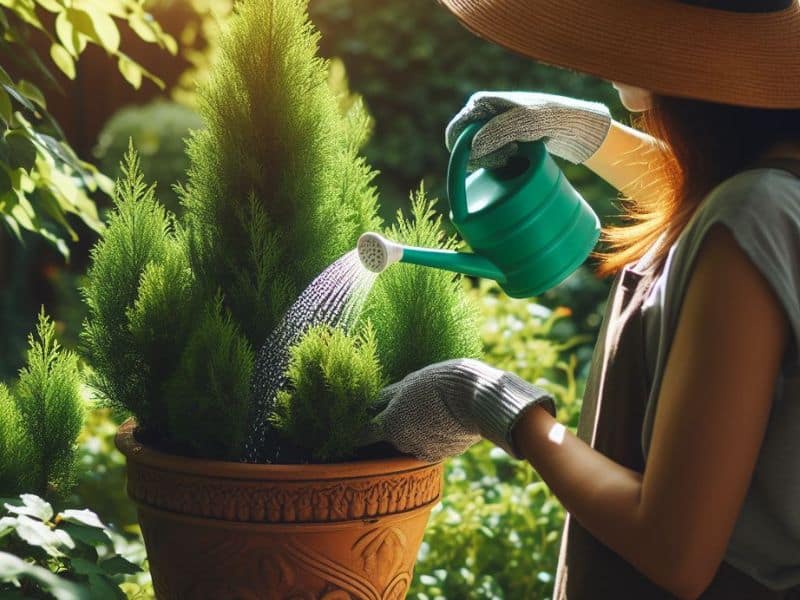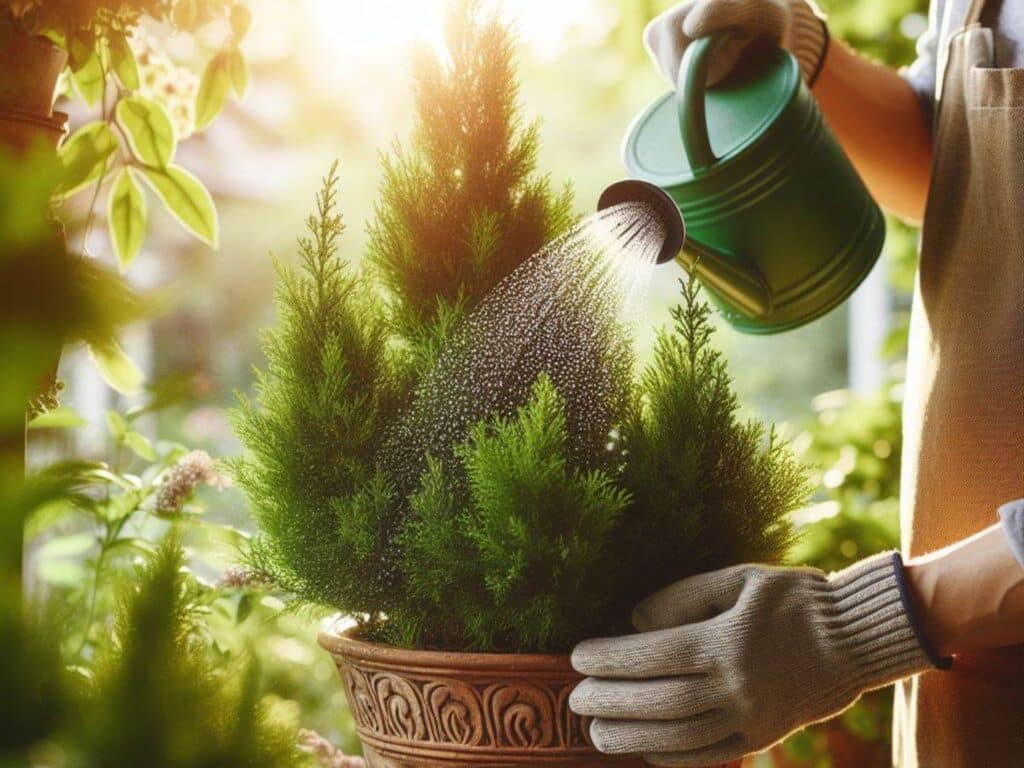Have you noticed your arborvitae looking less than its vibrant self lately? Overwatering may well be the culprit behind the wilting leaves and brown tips that are tarnishing its beauty.
Arborvitae, while hardy and resilient, are not immune to the pitfalls of excessive care. Understanding the delicate balance between too much and just enough water is crucial for the health of these evergreens.
The signs of overwatering can often mimic those of drought stress, making it a tricky situation to navigate. But don’t worry, you’re not alone in this. Identifying the problem is the first step towards a solution.
With the right knowledge and approach, you can reverse the damage and restore your arborvitae to its lush, green glory. Let’s dive into the causes, symptoms, and most importantly, the solutions to overwatered arborvitae, ensuring your greenery thrives for years to come.
Recognizing Overwatered Arborvitae
Signs and Symptoms
When your arborvitae starts looking more like it’s been through a rough patch rather than thriving, you may well be dealing with overwatering. The first tell-tale signs include a wilted appearance and brown tips on leaves, as previously mentioned.
However, there’s more to keep an eye out for. Yellowing of leaves, especially when it starts at the bottom and works its way up, is a textbook symptom of too much water. Soft, mushy spots on the trunk or a general sense of sogginess around the plant base also spell trouble.
If the soil feels more like a swamp and less like moist earth, that’s your cue to cut back on watering. These symptoms, while common in overwatered plants, often mimic those of underwatering, thereby complicating diagnosis.
Potential Dangers
If these signs are ignored, your arborvitae could head into risky territory. Persistent overwatering leads to root rot, a condition as grim as it sounds. Once root rot sets in, the plant’s ability to absorb water and nutrients severely diminishes, leading to its gradual decline.
Additionally, an overly moist environment is a playground for fungal diseases, which can spread not only to other parts of the arborvitae but also to neighboring plants.
This could potentially create a domino effect, jeopardizing an entire garden. Recognizing these dangers early on gives you a fighting chance to reverse the damage and nurse your arborvitae back to health. Remember, moderation is key in watering, just as in everything else gardening.
Causes of Overwatering in Arborvitae

When it comes to keeping your arborvitae healthy, the balance of water can be a tightrope walk. Too much, and you’re in a soggy situation. Following the previous focus on understanding the negative effects of overwatering, let’s dive into why this happens in the first place.
Irrigation Mistakes
First off, let’s talk about getting water to your arborvitae. It may well seem easy, but there’s a fine line between quenching its thirst and drowning it. One common error is using a one-size-fits-all approach to watering.
Just because your tomatoes need a drink every other day doesn’t mean your arborvitae shares that thirst. Overestimating the water requirement can lead to soggy soil conditions conducive to root issues.
Another pitfall is forgetting about the weather. A rainy week doesn’t need extra help from your hose, but it’s easy to stick to a schedule even when nature’s already done the job. Remember, your irrigation schedule needs to adapt to current weather conditions, not the other way around.
Environmental Factors
Beyond the hose, the environment around your arborvitae plays a big role. Poor drainage is a major player here. If water can’t escape, your arborvitae’s roots are essentially swimming. Make sure the planting site allows for proper drainage, or consider a raised bed or adjustments to the soil composition to prevent water from pooling.
Soil type also dictates how much watering is too much. Clay soils hold onto moisture much longer than sandy soils, often tricking gardeners into overwatering. If you’re not sure about your soil type, a quick test can save you and your arborvitae a lot of trouble down the line.
In a nutshell, knowing your garden’s specific needs and watching the sky will keep your arborvitae from becoming waterlogged. Remember, more water isn’t always the answer – sometimes, it’s the problem.
Healing an Overwatered Arborvitae
After identifying the woes of overwatering, let’s breathe new life into your arborvitae. Recovery is on the horizon with some strategic adjustments.
Adjusting Your Watering Schedule
First things first, let’s fine-tune your watering routine. It’s time to break free from the “one-size-fits-all” mindset. Each arborvitae has its thirst level, influenced by factors like sunlight exposure and soil type.
Start by decreasing your watering frequency. Instead of a rigid schedule, water only when the top inch of soil feels dry to the touch. This approach responds directly to your plant’s needs and the changing weather, instead of sticking to a calendar.
Soil Improvement Techniques
Soil that supports proper drainage makes all the difference for an arborvitae shaking off the effects of overwatering. If your soil holds water like a sponge, it’s cramming your plant’s roots. Mix in materials like compost or perlite to introduce some breathing room.
These amendments improve soil structure, allowing water to filter through efficiently, preventing root rot. Also, consider raising the planting bed to promote even better drainage, giving your arborvitae’s roots a dry place to call home.
Preventing Future Overwatering
After understanding the detrimental effects and reasons for overwatering arborvitae, let’s shift gears to focus on prevention. Keeping your arborvitae healthy requires a balance in watering practices, tailored not just to the plant’s needs but also considering the environmental conditions.
Proper Watering Techniques
Guesswork won’t cut it when it comes to watering arborvitae. Deep, infrequent watering encourages the roots to grow deeper, making the plant more drought-tolerant.
Typically, this means watering once a week with about an inch of water. However, this can vary based on climate and soil type. After watering, check the soil; it should feel moist, not soggy.
During rainy seasons, you may well not need to water at all. Remember, overwatering does more harm than good, so when in doubt, opt to hold off until the soil begins to dry out.
Tools and Technology for Irrigation Management
Leveraging technology can make a big difference in maintaining optimal moisture levels for arborvitae. Soil moisture sensors and smart irrigation systems can be game-changers, taking the guesswork out of when to water. These sensors provide real-time soil moisture readings, allowing you to adjust watering schedules accurately.
Smart irrigation systems can further refine this process by automatically adjusting watering based on weather forecasts and soil conditions. Investing in these tools not only saves water but also protects your arborvitae from the stress of over or under-watering. It’s a win-win for your garden and the environment.
Up next: Overwatered Snake Plant: Rescue and Prevention Guide







